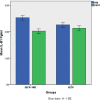Trimetazidine Improves the Outcome of EECP Therapy in Patients with Refractory Angina Pectoris
- PMID: 32801436
- PMCID: PMC7406001
- DOI: 10.5455/medarh.2020.74.199-204
Trimetazidine Improves the Outcome of EECP Therapy in Patients with Refractory Angina Pectoris
Abstract
Introduction: Cardiovascular disease (CAD) associated with death and disability remains a serious medical problem. In some patients the initial clinical coronary artery disease presentation is stable angina pectoris.
Aim: The aim of the study was to evaluate the effect of EECP therapy with or without trimetazidine (TMZ) in patients with refractory angina via modulating peripheral monocyte expression of Toll like receptor2 (TLR2) and its downstream signaling.
Methods: This is a double-blind randomized prospective study in which 88 stable refractory angina patients allocated into two groups, Enhanced External Counter Pulsation (EECP) group: included 44 patients with stable refractory angina, and were treated with EECP-Therapy. TMZ-EECP group: included 44 patients with stable refractory angina, we gave TMZ 35 mg twice daily in addition to EECP-Therapy.
Results: TLR2 expression in peripheral monocyte investigated by flow cytometry and 8-iso-prostaglandin F2β (8-iso-PGF2 β), interleukin1β (IL-1β), heat shock protein 60 (HSP60) and monocytes chemoattractant protein-1(MCP-1) were also measured before the EECP-therapy and before giving TMZ to patients, and after 35 hours of EECP treatment (7 consecutive weeks). Inhibition in TLR2 expression in peripheral monocyte was observed among the EECP group (P<0.05). Inflammatory cytokine MCP-1 was remarkably decreased in both study groups but (heat shock protein 60 (HSP60), MCP-1 and interleukin-1β (IL-1β)) significantly decreased levels were observed among the TMZ-EECP group (P<0.05). Also, the oxidative stress biomarker 8-iso-prostaglandin F2β (8-iso-PGF2β) was decreased in both study groups but significantly decreased levels were observed among the TMZ-EECP group (P<0.05). TMZ and EECP therapy in patients with stable refractory angina remarkably decreased the inflammatory markers HSP60, MCP-1 and IL-1β in serum levels also the decreased levels were found in serum levels of oxidative stress marker 8-iso-PGF2β serum level.
Conclusion: EECP-therapy decreased the expression of TLR2 on peripheral monocytes in patients with chronic stable refractory angina which yield improvement in the quality of patients' life by decreasing the frequency of angina episodes, decreasing the Short-acting nitrate use and change the exercise tolerance and distance.
Keywords: Enhanced External Counter Pulsation; Timetizidine.
© 2020 Saad Rasool Shaker, Fadhil Al-Amran, Ghizal Fatima, Hayder Al-Aubaid, Najah R. Hadi.
Conflict of interest statement
The authors declare no conflict of interest.
Figures










Similar articles
-
Enhanced External Counterpulsation (EECP): An Evidence-Based Analysis.Ont Health Technol Assess Ser. 2006;6(5):1-70. Epub 2006 Mar 1. Ont Health Technol Assess Ser. 2006. PMID: 23074496 Free PMC article.
-
Trimetazidine in Angina Combination Therapy--the TACT study: trimetazidine versus conventional treatment in patients with stable angina pectoris in a randomized, placebo-controlled, multicenter study.Am J Ther. 2005 Jan-Feb;12(1):35-42. doi: 10.1097/00045391-200501000-00006. Am J Ther. 2005. PMID: 15662290 Clinical Trial.
-
The immediate and long-term outcome of enhanced external counterpulsation in treatment of chronic stable refractory angina.J Intern Med. 2006 Mar;259(3):276-84. doi: 10.1111/j.1365-2796.2005.01604.x. J Intern Med. 2006. PMID: 16476105
-
Enhanced external counterpulsation: A unique treatment for the "No-Option" refractory angina patient.J Clin Pharm Ther. 2021 Apr;46(2):295-303. doi: 10.1111/jcpt.13330. Epub 2021 Jan 7. J Clin Pharm Ther. 2021. PMID: 33410549 Free PMC article. Review.
-
Efficacy and tolerability of trimetazidine in stable angina: a meta-analysis of randomized, double-blind, controlled trials.Coron Artery Dis. 2003 Apr;14(2):171-9. doi: 10.1097/00019501-200304000-00010. Coron Artery Dis. 2003. PMID: 12655281 Review.
Cited by
-
Predictors of adherence of enhanced external counterpulsation in patients with coronary heart disease after discharge: A mixed-methods study.Front Cardiovasc Med. 2022 Nov 25;9:1005958. doi: 10.3389/fcvm.2022.1005958. eCollection 2022. Front Cardiovasc Med. 2022. PMID: 36505377 Free PMC article.
-
Regulatory effects of trimetazidine in cardiac ischemia/reperfusion injury.Naunyn Schmiedebergs Arch Pharmacol. 2023 Aug;396(8):1633-1646. doi: 10.1007/s00210-023-02469-7. Epub 2023 Mar 27. Naunyn Schmiedebergs Arch Pharmacol. 2023. PMID: 36971866 Review.
-
Metabolic regulation to treat bipolar depression: mechanisms and targeting by trimetazidine.Mol Psychiatry. 2023 Aug;28(8):3231-3242. doi: 10.1038/s41380-023-02134-8. Epub 2023 Jun 29. Mol Psychiatry. 2023. PMID: 37386057 Free PMC article. Review.
References
-
- Rokitansky V, Freiherr K. A manual of pathological anatomy. 1855
Publication types
MeSH terms
Substances
LinkOut - more resources
Full Text Sources
Medical
Research Materials
Miscellaneous
